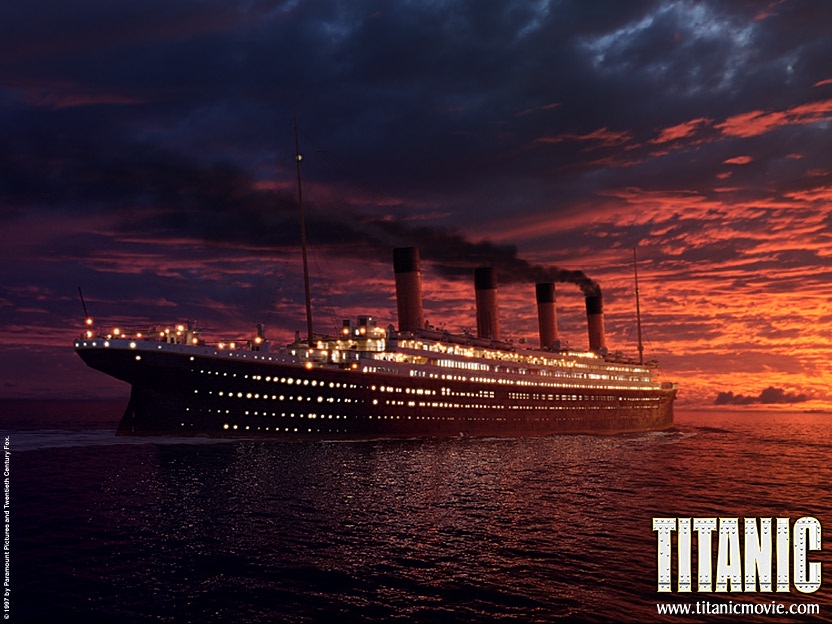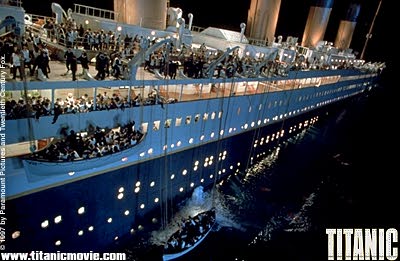It was now 11:40 on Sunday the 14th, the fifth night of Titanic's maiden crossing, and most of the passengers had retired for the night after the most delicious meal so far.
 The sun had set at about 7 p.m., and the
À la Carte Restaurant had closed at 11 that night. and lookouts Frederick Fleet and
Reginald Lee were in the crows' nest, looking for unsuspecting growlers and other
nuisances that may hinder the T's arrival time at New York. Equipped without binoculars,
the lookouts had to make the best of their eyesight. Then, out of the darkness appeared a
dark lump about the size of two tables, drawing closer and closer. Fleet jumped at once
for the bell, rang it three times, and telephoned the bridge. Sixth Officer Moody picked
up the phone. "What do you see?" "Iceberg, right ahead!" Fleet shouted
Moody relayed the news to First Officer Murdoch. Murdoch then gave the order "Hard
a'starboard!" to Quartermaster Hitchens, and then put the engine telegraph at
"Full Speed Astern" to cushion any impact the ship might have with the berg. Too
late. Thirty-seven seconds later, there was a soft grinding sound heard from the bridge
lasting for about ten seconds. A close shave, many think. Thomas Andrews was in his
stateroom going over things that should be changed for Titanic's next sister, Gigantic,
with her construction underway as of November of 1911. Too many screws on the coat racks,
the Reading and Writing Room should be downsized, and the wicker in the Café Parisen
should be stained green. To third class passengers in the forepeak, the collision was
nowhere near being soft and gentle. It came as a tremendous bang and in only a few minutes
time, G-Deck staterooms was already flooding. Daniel Buckley got up and told his roommates
to get out. They decided to ignore him, and a steward came down yelling for everyone to
get out. Buckley went up and never saw them again. In second class, passenger Lawrence
Beesley had been reading a book until the engines came to a stop. Nellie Becker and her
children had felt the engines stop too. She went to ask a steward what was wrong as she
was told not worry, probably just the loss of a propellor blade, and they'll be underway
soon. Esther Hart however, knew whatever had happened had fatally wounded the ship. For
the second time, she grabbed her daughter Eva and husband Benjamin and took
The sun had set at about 7 p.m., and the
À la Carte Restaurant had closed at 11 that night. and lookouts Frederick Fleet and
Reginald Lee were in the crows' nest, looking for unsuspecting growlers and other
nuisances that may hinder the T's arrival time at New York. Equipped without binoculars,
the lookouts had to make the best of their eyesight. Then, out of the darkness appeared a
dark lump about the size of two tables, drawing closer and closer. Fleet jumped at once
for the bell, rang it three times, and telephoned the bridge. Sixth Officer Moody picked
up the phone. "What do you see?" "Iceberg, right ahead!" Fleet shouted
Moody relayed the news to First Officer Murdoch. Murdoch then gave the order "Hard
a'starboard!" to Quartermaster Hitchens, and then put the engine telegraph at
"Full Speed Astern" to cushion any impact the ship might have with the berg. Too
late. Thirty-seven seconds later, there was a soft grinding sound heard from the bridge
lasting for about ten seconds. A close shave, many think. Thomas Andrews was in his
stateroom going over things that should be changed for Titanic's next sister, Gigantic,
with her construction underway as of November of 1911. Too many screws on the coat racks,
the Reading and Writing Room should be downsized, and the wicker in the Café Parisen
should be stained green. To third class passengers in the forepeak, the collision was
nowhere near being soft and gentle. It came as a tremendous bang and in only a few minutes
time, G-Deck staterooms was already flooding. Daniel Buckley got up and told his roommates
to get out. They decided to ignore him, and a steward came down yelling for everyone to
get out. Buckley went up and never saw them again. In second class, passenger Lawrence
Beesley had been reading a book until the engines came to a stop. Nellie Becker and her
children had felt the engines stop too. She went to ask a steward what was wrong as she
was told not worry, probably just the loss of a propellor blade, and they'll be underway
soon. Esther Hart however, knew whatever had happened had fatally wounded the ship. For
the second time, she grabbed her daughter Eva and husband Benjamin and took  them quickly to the Boat Deck. First
Class passenger Jack Thayer was wondering what all the fuss was about. "I'm going up
to see the fun." He told his parents. In the Allison staterooms, Nurse Alice Cleaver
became rather frantic. Hudson Allison scolded her and said to her that the ship was
unsinkable. After awhile, he decided to find out what was wrong, and went up top, leaving
Alice and a panicking wife, Bess Allison with the children Trevor and Lorraine. Sensing
that the ship was going to sink, Alice grabbed Master Trevor and headed for the Boat Deck.
The Titanic was engineered so that if she was struck in between two compartments, she
would remain afloat. The forward compartments were designed so that any three of the first
five compartments could be flooded and stay buoyant. Even more amazing was that she could
be filled up to the first four compartments and still not sink. A double hull wasn't even
bothered with because filling any more than this was deemed impossible. A double bottom
would be good enough. At thus, the Titanic was labeled "practically unsinkable."
Captain Smith soon arrived at the bridge. "What have we struck, Mr. Murdoch?"
"An iceberg sir." came Murdoch's reply. "I hard a'starboarded and reversed
the engines, and I was going to hard a'port around it, but she was too close. I could not
do any more." Smith looked at the commutator. In the first 10 minutes the ship was
already listing 5 degrees to starboard and 2 towards the bow. "My God." he
muttered. When Thomas Andrews came out of the boiler rooms to the bridge, he reported the
ship would live for another "Hour to an hour and a half." He noted that the berg
had torn into the first 6 compartments, to reveal damages to the first 300 feet of the
ship, with the first 5 compartments making water fast. The watertight bulkheads had not
gone high enough. They only closed off the spaces through G-Deck, 10 feet above the
waterline. Having any more than 4 compartments filled would pull the ship down, letting
water creep up the stairs, slop over E-Deck and down stairwells and air vents from one
compartment to another. Perhaps if the bulkhead between compartments 5 and 6 had gone one
deck higher, the ship would have stayed afloat. However, this is rather unlikely, as there
was a less known about damage sustained to the double bottom of compartment 7. This damage
was totally independent of the "gash" that would not be noticed until about 1:20
a.m., and seven flooding compartments would have the Titanic founder for sure.
them quickly to the Boat Deck. First
Class passenger Jack Thayer was wondering what all the fuss was about. "I'm going up
to see the fun." He told his parents. In the Allison staterooms, Nurse Alice Cleaver
became rather frantic. Hudson Allison scolded her and said to her that the ship was
unsinkable. After awhile, he decided to find out what was wrong, and went up top, leaving
Alice and a panicking wife, Bess Allison with the children Trevor and Lorraine. Sensing
that the ship was going to sink, Alice grabbed Master Trevor and headed for the Boat Deck.
The Titanic was engineered so that if she was struck in between two compartments, she
would remain afloat. The forward compartments were designed so that any three of the first
five compartments could be flooded and stay buoyant. Even more amazing was that she could
be filled up to the first four compartments and still not sink. A double hull wasn't even
bothered with because filling any more than this was deemed impossible. A double bottom
would be good enough. At thus, the Titanic was labeled "practically unsinkable."
Captain Smith soon arrived at the bridge. "What have we struck, Mr. Murdoch?"
"An iceberg sir." came Murdoch's reply. "I hard a'starboarded and reversed
the engines, and I was going to hard a'port around it, but she was too close. I could not
do any more." Smith looked at the commutator. In the first 10 minutes the ship was
already listing 5 degrees to starboard and 2 towards the bow. "My God." he
muttered. When Thomas Andrews came out of the boiler rooms to the bridge, he reported the
ship would live for another "Hour to an hour and a half." He noted that the berg
had torn into the first 6 compartments, to reveal damages to the first 300 feet of the
ship, with the first 5 compartments making water fast. The watertight bulkheads had not
gone high enough. They only closed off the spaces through G-Deck, 10 feet above the
waterline. Having any more than 4 compartments filled would pull the ship down, letting
water creep up the stairs, slop over E-Deck and down stairwells and air vents from one
compartment to another. Perhaps if the bulkhead between compartments 5 and 6 had gone one
deck higher, the ship would have stayed afloat. However, this is rather unlikely, as there
was a less known about damage sustained to the double bottom of compartment 7. This damage
was totally independent of the "gash" that would not be noticed until about 1:20
a.m., and seven flooding compartments would have the Titanic founder for sure.